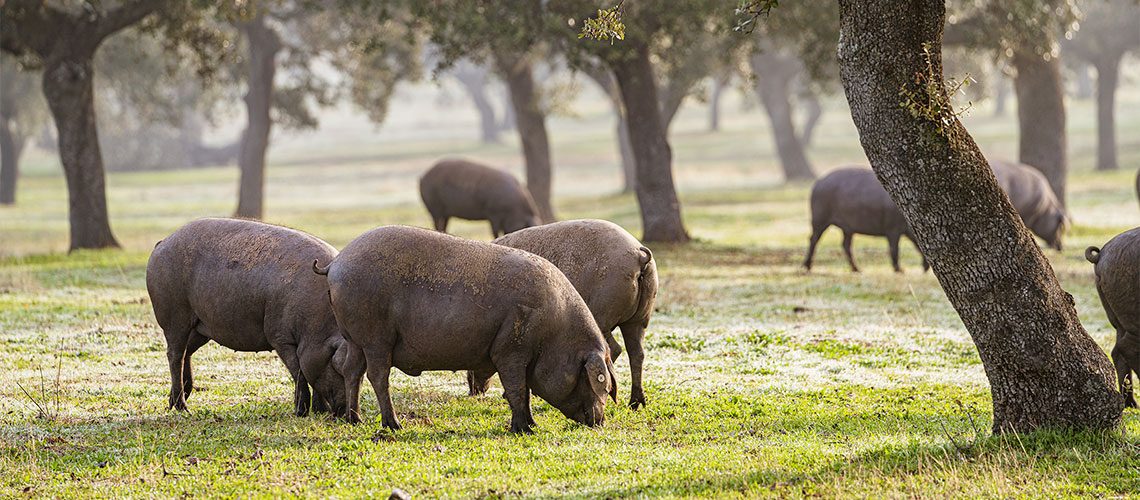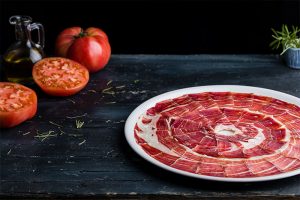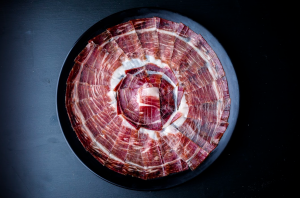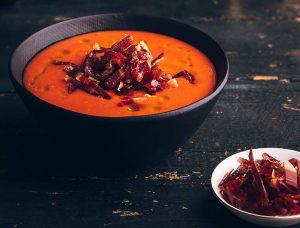La Montanera is a specific phenomenon related to raising pigs. It just so happens that it only occurs with Iberian pigs, and not with any other animal. In this post we will tell you more about this phenomenon.
What is La Montanera?
La Montanera refers to the fattening period of Iberian pigs— when they roam free in the Spanish pastures, feeding on grasses, natural herbs, and acorns, with the ultimate goal of achieving the proper weight before they are taken to be butchered. This season takes place during fall and winter. More precisely, this occurs starting at the end of October or beginning of November, until March of the following year. This coincides with the acorn ripening period, the base of the pigs’ diet.
Only the most prized Iberian pigs make it to this last phase:
- They can be neither Iberian piglets nor too old, in order to take full advantage of their fattening potential and optimal fat content
- They must have the best characteristics
- They must weigh less than 110-115 kg (243 -2534 lb)
The proportion is actually very small: of the 30 million pigs in Spain, 2 million are of the Iberian breed. Of those, 350,000 are raised on acorns, and only 150,000 are Iberian pigs fed 100% on acorns and tagged with the official black tag.
Pig Activity During the Montanera Period
The current regulations determine how much the pigs should eat. In the Montanera period it should gain a minimum of 46 kg (101 lb). During this time, the pig can drink up to 50 liters of water a day and eat up to 12 kg (26 lb) of acorns and 5 kg (11 lb) of grasses, plants, roots, and mushrooms. With this combination the pig gains more than 50% of its final body weight. On average they start off at 90 kg (198 kg) and end up at 160 kg (353 lb).
Much of their food intake can be attributed to their physical activity. During this period the pig lives free range and thus is in constant movement and always exercising. They actually walk between 12 and 15 km (7 and 9 miles) per day looking for their favorite acorns.
The acorns provide fat in their lean meat without altering what is called their “morphology,” or organismal structure. This physical activity helps their muscle fibers transform into better food material.
The Diet of Iberian Pigs in the Pasture
The star of the pigs’ diet during the Montanera season is the acorn. This incredibly healthy food provides the animal with a fat content similar to that of olive oil, which contributes to the organoleptic qualities of the jamón, as well as its flavor, texture, and aroma.
What type of acorns to Iberian pigs eat? Not any acorn will do— only those that come from holm oak trees or cork oak trees.
Because of the aroma, the animals can detect which are still unripe, and they will leave these unripe acorns for later.
In terms of the way the pigs eat the acorns, they don’t simply gobble them up. Instead, they peel them and leave the shells under the trees like a trail of footprints.
The Pasture: The Place Where Pigs Roam Free
The Montanera period takes place in the pasture, in a type of Mediterranean forest unique to Spain filled with holm and cork oak trees, wild shrubs, and grasslands. This unique biodiversity has been meticulously cared for throughout many centuries.
The climate is very important for a good Montanera season:
- A drought results in a lower production of acorns and the ones that actually do grow don’t ripen properly.
- A frost can affect the blooming and flowering period of the acorns, resulting in a lower production.
- The heat can cause the acorns to fall too early, leaving them unripe and overall low in quality.
As with any natural environment, each Spanish pasture is distinct. And thus, so is every Montanera.
How Many Pigs are in Each Pasture?
The number of pigs allowed per hectare in the pasture comes specified in the Royal Decree of the Iberian Quality Standards 4/2014.
The number comes from the number of holm and cork oak trees and the characteristics of each Montanera: the quality standards require that there be no more than 1.25 pigs per hectare (about 2.5 acres), although the number can vary up to 0.8 depending on the number of holm oak trees. This guarantees that all the animals are fed correctly.
La Montanera in COVAP
At Ibéricos COVAP USA we take special care to make sure our products meet this desired quality, which is why the Montanera is such an important season in our pastrues. In fact, Ibéricos COVAP received the AENOR certificate of animal welfare based on the European benchmark of Welfare Quality.
To share and display this special care we give to our animals, we launched COVAP Montanera Live, a live streaming of our free-range pigs. It is, without a doubt, a sight to see. You can check it out on this page from October or November until February.
Ultimately, the Montanera is an important season. Without it, the quality of our jamón ibérico wouldn’t be the same. Instead, the pigs would eat a base of grains and animal feed, resulting in a meat with other nutritional and organoleptic qualities.






